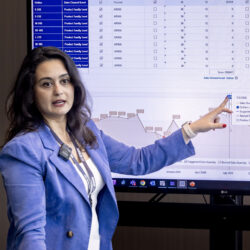Every S&OP supplier has their own take on supply chain

S&OP software vendors show significant maturity in their general planning functionality, but differ greatly in their approach to industry-specific issues. That was one of the conclusions attendees drew after participating in the second S&OP Demo Day this year. This time, the focus was on manufacturing companies, and five software vendors – Icron, Relex, iPlan, Remira and Diskover – showed what they have to offer for that sector.
By Harm Beerens
At the start of the event, the participants who have arrived at the Park Plaza Amsterdam Airport hotel are given a piece of practical advice by event chair Martijn Lofvers (pictured). ‘When selecting an S&OP software supplier, don’t just look at the functionality, but also check whether the supplier has specific experience in your sector.’ This turns out to be a very relevant tip, because there is quite a bit of difference between suppliers in that respect.
One of the participants is Bart Dierickx, head of E2E supply chain transformation at DS Smith, an international carton packaging company with a network of production sites. ‘The complexity for us is related to the large number of facilities where we produce paper or packaging. We make that paper for ourselves, to make packaging from, and sell it to external customers. However, we don’t make all the paper we need ourselves, so we also buy some in,’ says Dierickx.
To control all those internal and external goods flows, the packaging company has an IBP process. ‘For this, we often use tools inherited from the companies DS Smith has acquired over the years. We are now looking for a new S&OP suite that integrates all the components which can take our paper-flow planning to a higher level of performance.’
Good time to reflect
‘I am very curious about the latest developments in AI within S&OP,’ reveals Director of Supply Chain Planning Peter van Weeghel of chemical producer Quaker Houghton. ‘We started S&OP two years ago and we are working with a software system based mainly on heuristic models. For me, this afternoon is a good time to reflect. Where is the market moving? Do we still have the right tools? And the companies here today are all interesting. Not the big well-known names from Gartner’s Magic Quadrant, but vendors from the segment just below. I feel that they focus a bit more on specific industries, for which they have very innovative solutions.’
One example of such an industry-focused S&OP player is UK-based iPlan. ‘We have been around for 25 years and have been focusing on the processing industry for all that time. So we know this sector like no other,’ states Jack Cheesbrough at the start of his demo. Typical iPlan customers are companies in the paper and packaging industry and bottling plants, for example. ‘These are usually low-margin companies whose S&OP includes managing fluctuations in raw material and energy prices,’ Cheesbrough continues. ‘We support them in this at all planning levels, ranging from IBP and supply chain design to order promising and real-time rescheduling of production lines.’
Divergent processes
Whereas iPlan’s planning software is particularly suitable for batchwise, divergent production processes, the German company Diskover’s software is more tailored to discrete production. For companies with a complex bill of materials, for example, where input materials and components come together to eventually form a single end product.
‘In our home market, we have many machine builders as clients and we are a lot better known there than here in the Netherlands,’ says Dirk Ungerechts of Diskover. The Aachen-based company has always been a supply chain consultancy, but to offer customers software as well, it set up sister company SCT 15 years ago. Today, this offers a fully-fledged APS suite, ‘but one that is quick to implement’, Ungerechts assures the audience. ‘Often, we can get the planning up and running at a client’s premises in as little as two days.’
 All five vendors structured their demos according to the steps of an S&OP process: forecasting, scenario planning, demand planning, and the translation to production and purchasing. Additionally, S&OP software for manufacturing companies should also include smart planning algorithms that optimize plants and production lines, for example.
All five vendors structured their demos according to the steps of an S&OP process: forecasting, scenario planning, demand planning, and the translation to production and purchasing. Additionally, S&OP software for manufacturing companies should also include smart planning algorithms that optimize plants and production lines, for example.
During Icron’s demo, this is made very clear using a heat map. Colours indicate the utilization rate per month and per production line. Melis Teksan (pictured) of Icron: ‘If you click on it, you can see what is planned for that period, and you can also simulate what will happen if demand increases even more, for instance. You can then decide which customers to supply and which not. Or you can consider scheduling overtime in that period.’
Roots in retail and distribution
Whereas iPlan and Diskover have their roots in manufacturing environments, Remira and Relex have traditionally been more involved with retailers and distributors. ‘We offer omnichannel commerce solutions, among other things, and even have some logistics service providers as clients,’ states Remira’s Uneco de Meester. ‘With the acquisition of planning and S&OP specialist Outperform in 2021, we also started to focus more on manufacturing companies, especially in the food & beverage segment.’
Finnish company Relex has experienced a similar development. It previously served mainly retail customers, including Coop, Lidl and Rewe, but following the acquisition of Sweden’s Optimity also set its sights on companies more upstream in the chain. Robin Tunderman of Relex says: ‘The addition of Optimity to our existing product portfolio means we can now offer suppliers of consumer packaged goods a complete end-to-end supply chain solution as well.’
During Relex and Remira’s S&OP demos, it becomes clear where they differ from their purely manufacturing-focused colleagues. There is much more emphasis on distribution and managing stock in distribution centres. Tunderman of Relex: ‘We are used to forecasting demand at consumer level and, with the help of AI, we can include the impact of weather forecasts, among other things. We also provide insight into the impact of service levels on inventory or how to use promotions to steer your demand in the desired direction.’ These are typical retail functionalities that Relex now also offers to food & beverage companies as part of a total package.
Own approach
Peter van Weeghel of Quaker Houghton mentions during the break that he has already learned a lot. ‘They all offer the basic functionality for S&OP, all with pretty high maturity. But in addition, each supplier chooses their own approach. I saw something in every demo that could be interesting for us. Relex’s story, for instance, was very resonant, even though it was more focused on food & beverage. It was about batch production, about packaging processes, about limited shelf life of raw materials; these are all issues that are just as relevant to us as a specialty chemicals company. In Icron’s demo, I found the optimization algorithms very strong, and what appealed to me in Diskover’s tool was the scheduling of semi-finished products and components. That also plays into our business.’
Industry focus in S&OP selection
 So what actually makes an S&OP tool industry-specific, and how heavily should that be factored into a selection process? This remains a topic of discussion after the meeting. ‘We do not focus on one specific sector but on a broad group of companies,’ explains Melis Teksan of Icron. The company has customers in chemicals, high-tech, food, automotive and everything in between. ‘If I look at where the difference is in terms of implementation, among other things it is in the planning algorithms we deploy for each company. Depending on the type of production process, you have different optimization rules.’
So what actually makes an S&OP tool industry-specific, and how heavily should that be factored into a selection process? This remains a topic of discussion after the meeting. ‘We do not focus on one specific sector but on a broad group of companies,’ explains Melis Teksan of Icron. The company has customers in chemicals, high-tech, food, automotive and everything in between. ‘If I look at where the difference is in terms of implementation, among other things it is in the planning algorithms we deploy for each company. Depending on the type of production process, you have different optimization rules.’
A key aim of paper-flow planning at DS Smith is to optimize the make-or-buy decision, states Bart Dierickx. ‘What can we make ourselves and what can we better buy in? It would be great if a planning system comes up with suggestions for this. We are in talks with iPlan, a specialist in our industry, to learn what they can offer us in this area and how they can tackle our other challenges.’ He enjoys talking to iPlan, he says, because they already know the paper sector well. ‘It seems obvious to me that you can take faster steps forward with a software vendor that is familiar with your sector. That way, less energy goes into getting to know our issues and there is also less chance of misunderstandings.’
Financial targets
Apart from different planning algorithms, there are also industry-specific differences in the way demand planning is done. One company can partly steer demand itself, while another depends on tenders. This requires a very different S&OP process. A not insignificant part of demand planning also relates to aligning demand with financial targets. During the demos, it becomes clear that each supplier has their own ideas about this. Icron’s dashboard, for instance, compares demand plans with budgeted sales by default, whereas Diskover’s S&OP solution does not show the financial figures at all.
‘Our experience is that when you add in budgets, people tend to adjust their forecasts to what was once thought up by Finance long ago,’ says Diskover’s Dirk Ungerechts in explanation. ‘This creates unrealistic sales forecasts that lead to a company building up too much inventory or reserving more production capacity than needed. These are all things you want to counteract with S&OP.’ These different views stem from the ability to influence demand. Within the consumer packaged goods sector, that opportunity is plentiful, but if you are a machine builder – as many of Diskover’s customers are – you have much less influence over demand.
Best of both worlds
 For most attendees, the afternoon was very successful, they say afterwards. ‘The event is small-scale, so the demos were very intimate,’ responds Peter van Weeghel of Quaker Houghton. ‘There were only a few other companies in the room each time, so the vendors could really zoom in on what was of interest to us. This made the afternoon very efficient for me. If I would have had to organize a separate demo with each of those suppliers myself, I would have spent a lot more time on that. And what’s more, I’ve now also met several industry colleagues with whom I’ve exchanged experiences. So this is the best of both worlds.’
For most attendees, the afternoon was very successful, they say afterwards. ‘The event is small-scale, so the demos were very intimate,’ responds Peter van Weeghel of Quaker Houghton. ‘There were only a few other companies in the room each time, so the vendors could really zoom in on what was of interest to us. This made the afternoon very efficient for me. If I would have had to organize a separate demo with each of those suppliers myself, I would have spent a lot more time on that. And what’s more, I’ve now also met several industry colleagues with whom I’ve exchanged experiences. So this is the best of both worlds.’
Bart Dierickx of DS Smith concurs. ‘45 minutes might be on the short side for a demo, but it means you can talk to five vendors in one afternoon, with whom you can always request a follow-up meeting. It was also convenient for me that it was near Amsterdam Airport Schiphol, as we have our office nearby. It was a very useful afternoon.’










